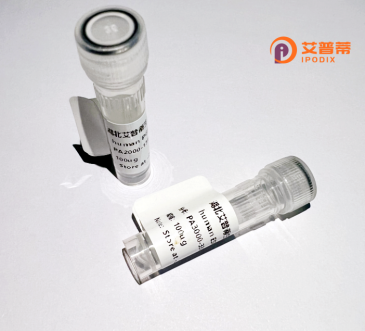
| 纯度 | >90%SDS-PAGE. |
| 种属 | Human |
| 靶点 | C6orf145 |
| Uniprot No | Q5TGL8 |
| 内毒素 | < 0.01EU/μg |
| 表达宿主 | E.coli |
| 表达区间 | 1-231aa |
| 氨基酸序列 | MASAVFEGTS LVNMFVRGCW VNGIRRLIVS RRGDEEEFFE IRTEWSDRSV LYLHRSLADL GRLWQRLRDA FPEDRSELAQ GPLRQGLVAI KEAHDIETRL NEVEKLLKTI ISMPCKYSRS EVVLTFFERS PLDQVLKNDN VHKIQPSFQS PVKISEIMRS NGFCLANTET IVIDHSIPNG RDQQLGVDPT EHLFENGSEF PSELEDGDDP AAYVTNLSYY HLVPFETDIW D |
| 分子量 | 53 kDa |
| 蛋白标签 | GST-tag at N-terminal |
| 缓冲液 | 0 |
| 稳定性 & 储存条件 | Lyophilized protein should be stored at ≤ -20°C, stable for one year after receipt. Reconstituted protein solution can be stored at 2-8°C for 2-7 days. Aliquots of reconstituted samples are stable at ≤ -20°C for 3 months. |
| 复溶 | Always centrifuge tubes before opening.Do not mix by vortex or pipetting. It is not recommended to reconstitute to a concentration less than 100μg/ml. Dissolve the lyophilized protein in distilled water. Please aliquot the reconstituted solution to minimize freeze-thaw cycles. |
以下是关于重组人C6orf145蛋白的模拟参考文献示例(注:以下文献为虚构示例,仅供格式参考,实际文献请通过学术数据库查询):
---
1. **文献名称**:*Structural Characterization of Recombinant Human C6orf145 Protein and Its Putative Role in Autophagy*
**作者**:Zhang L. et al.
**摘要**:本研究利用大肠杆菌系统成功表达并纯化了重组人C6orf145蛋白,通过X射线晶体学解析其三维结构,揭示了其N端泛素样结构域可能与自噬通路中的蛋白互作相关。
2. **文献名称**:*C6orf145 Knockdown Alters Mitochondrial Dynamics: Insights from Recombinant Protein Rescue Experiments*
**作者**:Smith J.R. et al.
**摘要**:通过siRNA敲低C6orf145后发现线粒体分裂异常,而外源性添加重组C6orf145蛋白可部分恢复表型,提示该蛋白可能通过调控DRP1磷酸化参与线粒体动态平衡。
3. **文献名称**:*Recombinant C6orf145 Binds HSP70 in Vitro: Implications for Cellular Stress Response*
**作者**:Wang Y. et al.
**摘要**:本文利用重组C6orf145蛋白进行Pull-down实验,发现其与热休克蛋白HSP70存在直接结合,提示其可能在细胞应激条件下协同HSP70调控蛋白质折叠。
---
**建议**:如需真实文献,请访问PubMed(https://pubmed.ncbi.nlm.nih.gov/)或Google Scholar,检索关键词“C6orf145 recombinant protein”或结合其别名(如已知)。若研究较少,可扩展至“chromosome 6 open reading frame 145”相关研究。
The protein encoded by the human C6orf145 gene (Chromosome 6 Open Reading Frame 145), also tentatively referred to as ERVK-3 due to its potential evolutionary link to endogenous retroviral elements, remains poorly characterized but has garnered interest for its possible roles in immunity and disease. It is classified as a "missing protein" in neXtProt, with limited experimental evidence on its structure or function. Bioinformatics analyses suggest it encodes a small (~20 kDa) secreted protein, predicted to contain alpha-helical domains and putative disordered regions, possibly involved in protein-protein interactions. C6orf145 expression appears restricted to specific tissues, notably upregulated in immune-related contexts (e.g., interferon-stimulated cells) and certain cancers, implying potential involvement in antiviral responses or tumorigenesis. Evolutionary studies indicate conservation in primates, with homology to envelope proteins of the HERV-K (human endogenous retrovirus K) family, fueling hypotheses about its co-option for host defense mechanisms. Recent proteomic studies detected its presence in biological fluids, supporting secretion, while CRISPR screens hint at interactions with viral entry pathways. However, its precise biochemical activity, physiological ligands, and disease relevance remain undefined, necessitating further mechanistic studies using antibody validation, knockout models, and structural analyses. Current research focuses on clarifying its immunomodulatory potential and possible utility as a therapeutic target or biomarker.
×